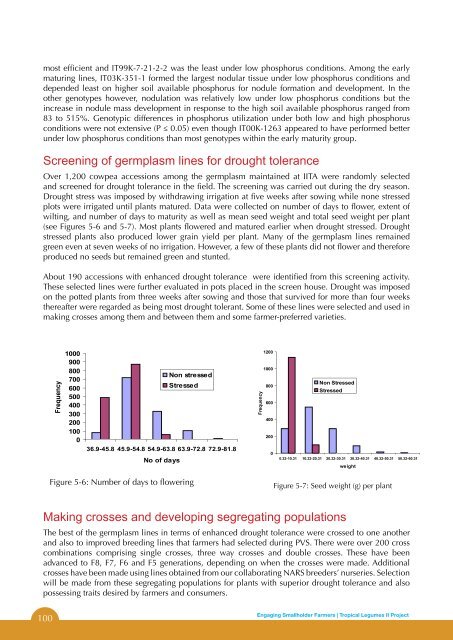Final version of Tropical Legumes II Project Report for Phase 1 - icrisat
Final version of Tropical Legumes II Project Report for Phase 1 - icrisat
Final version of Tropical Legumes II Project Report for Phase 1 - icrisat
You also want an ePaper? Increase the reach of your titles
YUMPU automatically turns print PDFs into web optimized ePapers that Google loves.
most efficient and IT99K-7-21-2-2 was the least under low phosphorus conditions. Among the early<br />
maturing lines, IT03K-351-1 <strong>for</strong>med the largest nodular tissue under low phosphorus conditions and<br />
depended least on higher soil available phosphorus <strong>for</strong> nodule <strong>for</strong>mation and development. In the<br />
other genotypes however, nodulation was relatively low under low phosphorus conditions but the<br />
increase in nodule mass development in response to the high soil available phosphorus ranged from<br />
83 to 515%. Genotypic differences in phosphorus utilization under both low and high phosphorus<br />
conditions were not extensive (P ≤ 0.05) even though IT00K-1263 appeared to have per<strong>for</strong>med better<br />
under low phosphorus conditions than most genotypes within the early maturity group.<br />
Screening <strong>of</strong> germplasm lines <strong>for</strong> drought tolerance<br />
Over 1,200 cowpea accessions among the germplasm maintained at <strong>II</strong>TA were randomly selected<br />
and screened <strong>for</strong> drought tolerance in the field. The screening was carried out during the dry season.<br />
Drought stress was imposed by withdrawing irrigation at five weeks after sowing while none stressed<br />
plots were irrigated until plants matured. Data were collected on number <strong>of</strong> days to flower, extent <strong>of</strong><br />
wilting, and number <strong>of</strong> days to maturity as well as mean seed weight and total seed weight per plant<br />
(see Figures 5-6 and 5-7). Most plants flowered and matured earlier when drought stressed. Drought<br />
stressed plants also produced lower grain yield per plant. Many <strong>of</strong> the germplasm lines remained<br />
green even at seven weeks <strong>of</strong> no irrigation. However, a few <strong>of</strong> these plants did not flower and there<strong>for</strong>e<br />
produced no seeds but remained green and stunted.<br />
About 190 accessions with enhanced drought tolerance were identified from this screening activity.<br />
These selected lines were further evaluated in pots placed in the screen house. Drought was imposed<br />
on the potted plants from three weeks after sowing and those that survived <strong>for</strong> more than four weeks<br />
thereafter were regarded as being most drought tolerant. Some <strong>of</strong> these lines were selected and used in<br />
making crosses among them and between them and some farmer-preferred varieties.<br />
Frequency<br />
1000<br />
900<br />
800<br />
700<br />
600<br />
500<br />
400<br />
300<br />
200<br />
100<br />
0<br />
Non stressed<br />
Stressed<br />
Frequency<br />
1200<br />
1000<br />
800<br />
600<br />
400<br />
200<br />
Non Stressed<br />
Stressed<br />
36.9-45.8 45.9-54.8 54.9-63.8 63.9-72.8 72.9-81.8<br />
No <strong>of</strong> days<br />
0<br />
0.32-10.31 10.32-20.31 20.32-30.31 30.32-40.31 40.32-50.31 50.32-60.31<br />
weight<br />
Figure 5-6: Number <strong>of</strong> days to flowering<br />
Figure 5-7: Seed weight (g) per plant<br />
Making crosses and developing segregating populations<br />
The best <strong>of</strong> the germplasm lines in terms <strong>of</strong> enhanced drought tolerance were crossed to one another<br />
and also to improved breeding lines that farmers had selected during PVS. There were over 200 cross<br />
combinations comprising single crosses, three way crosses and double crosses. These have been<br />
advanced to F8, F7, F6 and F5 generations, depending on when the crosses were made. Additional<br />
crosses have been made using lines obtained from our collaborating NARS breeders’ nurseries. Selection<br />
will be made from these segregating populations <strong>for</strong> plants with superior drought tolerance and also<br />
possessing traits desired by farmers and consumers.<br />
100<br />
Engaging Smallholder Farmers | <strong>Tropical</strong> <strong>Legumes</strong> <strong>II</strong> <strong>Project</strong>
















